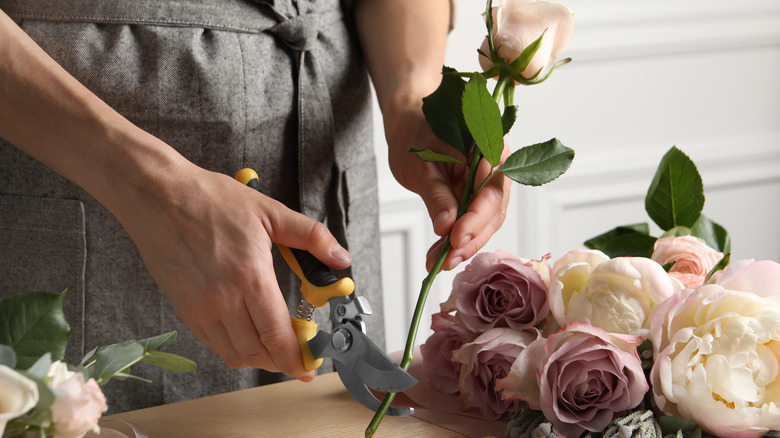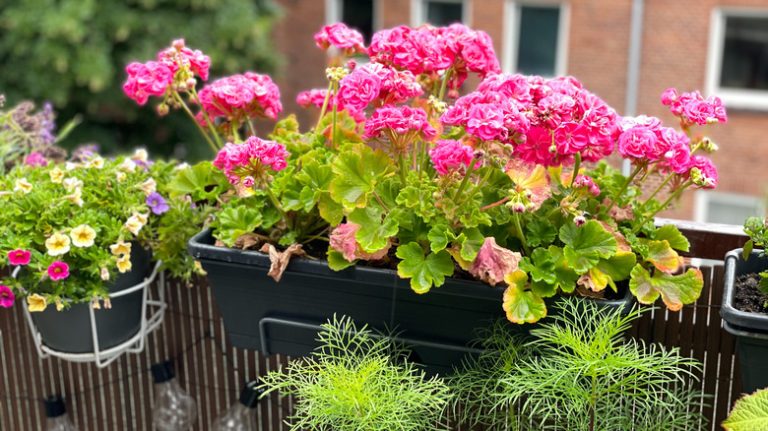There’s something special about adding a vase of fresh-cut flowers to your living space; it’s a small touch, but one that changes the entire vibe. The sense of intention, the feeling of bringing nature inside, the pop of color, and the positive moods associated with flowers are all reasons to put a vase on the dining room table, the mantlepiece, or wherever else you can find room. And while many indoor houseplants smell amazing, there’s nothing that quite does it like fresh flowers that you’ve cut, placed, and enjoy the scent of … while that scent lasts.
However, cut flowers don’t last forever. Have you had a hard time keeping them thriving for more than a few days? You’re not alone, and that’s why House Digest did an exclusive interview with Liz Will — Master Gardener, certified garden coach, and founder of Learn to Grow Gardens – to gain insight on helping them last longer. As Will explains, “Keeping cut flowers fresh is easy. If you follow these steps, your cut flower arrangement should last far longer than plopping it into a vase with plain water.” Here’s how to get started.
Choose the right vase for your cut flowers

While you may choose any vase style you like, it’s also important to be sure the vase is ready to do its job — keep flowers lasting longer. As Master Gardener Liz Will told House Digest in our exclusive interview, “You’ll want to use a vase that’s clean and free from residue or leftover detergents.” It’s not uncommon for such buildup to occur if the vase wasn’t properly cleaned before being stored. There could be mold, mildew, or bacteria present, or there could be residue from previous soaps used in cleaning attempts.
Will offers specific steps to ready the vase. “Freshly wash the vase in hot, soapy water and rinse it thoroughly. An additional soak in a solution of 1 part bleach to 10 parts water will kill any bacteria in the vase that could shorten the lifespan of your bouquet.” Keep in mind that it’s a good idea to do this even if you’ve run the vase through the dishwasher, as taking the extra time and care can provide just a bit more protection against bacteria for your new flowers.
Cut the stems of your flowers

Whether you’re bringing flowers in from your garden or purchasing them from a store, preparing the stems themselves is the next step before putting them into the water. According to Master Gardener Liz Will, there are a few specifics to this process, if you want to ensure maximum longevity. “Using clean garden sheers or sharp scissors, cut the stems of your flowers at a 45-degree angle, preferably under water. Doing so underwater prevents air bubbles from forming, blocking the intake of water up the stem.” Refrain from using a kitchen knife for this task as it may cause breakage to the stem, leaving it less able to soak in the water it needs.
Ensuring the stems can absorb as much water as possible is critical to the flowers lasting longer and looking their best. “Cutting the stems at a 45-degree angle keeps them from lying flat in the bottom of your container, which can also block water from traveling up the stems,” reveals Will.
Remove the leaves below the water line

New Africa/Shutterstock
Remember that bacteria that grew in the vase from the last time you put flowers out? Here’s how to avoid that happening again. “Leaves remaining in vase water will rot, leading to bacteria and algae growth,” Liz Will explained in House Digest’s exclusive interview. Indeed, it only takes a few snips of the garden sheers to clear these away, so it’s an easy step that ensures better results. Getting rid of them can also help draw attention to the flower buds instead of the base of a clear vase.
Will continues, “Trimming any leaves below the water line keeps the water in your vase fresh for much longer.” If the stems are not very long, try a shorter vase to avoid clouding up the water with too much organic material. You’ll know there’s a problem if the water becomes murky and clouded within just a short time of putting the stems into it. That discolored water is also an eyesore and may encourage you to get rid of your flowers too soon.
Feed your cut flowers

TabitaZn/Shutterstock
Many flowers receive extensive nutrients during their growing process, so much so that they depend on that nutrition base to thrive. When you’ve cut them, they can no longer pull in nutrition, especially indoors and out of the sun. As Liz Will tells House Digest, “Even cut flowers need to be fed to look their best. You can purchase premade flower food or make your own.”
If you’re already in the middle of this process without any plant food, it’s easy enough to make your own. Will shares, “To make your own, add 2 tablespoons of lemon juice, 1 tablespoon of sugar, and a few drops of bleach to every quart of vase water.” Most of those ingredients are likely in your pantry. The bleach may seem out of place, but it’s quite important. “The bleach keeps bacteria from forming, and the sugar feeds the flowers,” Will reveals. This could help your flowers look fresh and like new for numerous days.
Change the water on your cut flowers every few days

Adam Yee/Shutterstock
Without a doubt, the quality of the water your flowers are living in is going to dramatically impact the overall lifespan of the plants. In her exclusive interview with House Digest, Liz Will emphasized that point: “Every three to four days, refresh the water in your vase with fresh water and more flower food.” It may be important to do this even if the water remains clear since you’ll be providing another boost of important nutrients to the stems.
You can also pay close attention to the changes in the flowers as they get a little older. Will states, “You can also trim 1 inch off of each stem to open them back up and allow the stems to pull up more water and nutrients.” This could rejuvenate the flowers, giving them the ability to brighten up again as they get a sudden surge of new nutrients. Try to do this before they start to wilt for the best overall results.
Refrigerate the bouquet

Pixel-Shot/Shutterstock
Perhaps you have a family dinner party this weekend, and you want your flowers to look the very best so you don’t have to replace them. If that’s the case, you could take a more aggressive approach, according to Master Gardener Liz Will. “An additional tip to extend the life of your flowers is placing the entire boutique in the fridge each night and removing it in the morning. The cooler air in the fridge slows down the aging process, prolonging the life of your bouquet.” So if that is your goal, clear out some space in a spare fridge, if possible, to take full advantage of the added days of beauty.
By following all of these expert tips, you’ll easily be able to give your flowers a longer, prettier life. There are many beneficial reasons to keep fresh flowers in your home year-round, but you don’t want to be replacing them every few days; this way, with just a few minutes of preparation and a healthy dose of nutrients, your beautiful flowers will last longer and look better doing so.



